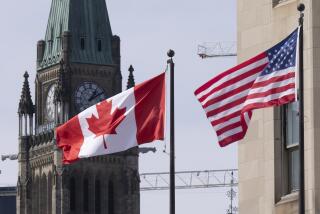Canada : Anti-Smoking Drive Offers Lessons for U.S. : Events north of the border, where the high court just threw out a ban on tobacco ads, serve as an example.
TORONTO â Canadaâs law prohibiting virtually all tobacco advertising has been junked by this countryâs Supreme Court, and government regulators are contemplating new, less comprehensive restrictions.
But the question persists: Did Canadaâs ad ban do much to curtail smoking?
Opinion--and statistics--are divided on that issue, as well as on many other aspects of this nationâs anti-smoking legislation, which has long been promoted as a model for other countries.
Still, an examination of the Canadian experience offers potential lessons for the Clinton Administration as it gets tough on tobacco companies in the United States.
Here, according to health professionals, anti-smoking advocates and tobacco industry lobbyists, are some of them:
Lesson 1: Hazy Links
Links between ad limits and smoking reduction are, experts note, hazy.
The Canadian ad ban was part of a comprehensive government anti-smoking campaign begun in the 1980s. The campaign has also included high taxes on tobacco products, boldly printed health warnings on packages, a near-prohibition on cigarette vending machines and limits on smoking in public places.
That is one reason it is tough to isolate the impact of the ad limits.
But all parties agree that the percentage of Canadians who smoke has declined since the anti-smoking push began nearly 15 years ago.
Trouble is, the decline started before the government began imposing restrictions and has more or less leveled out since 1990, a year after the ad ban was put into effect.
Tobacco industry officials also point out that a larger percentage of Canadians smoke than do Americans, despite lower cigarette prices and fewer advertising restrictions in the United States.
The anti-smoking lobby counters that per capita consumption of cigarettes here dropped below that in the United States following government action.
âThereâs no magic bullet here,â concludes Bill Maga, a senior policy analyst in the Health Ministry. âThis is a complex social-psychological phenomenon that goes beyond just one element, be it price or advertising. It goes to a lot of factors--who your parents are, social background, friends.â
Maga adds, however, that in a total anti-smoking package, some restrictions on advertising are a logical inclusion.
Lesson 2: Target Youth
Among those 15 to 19 years of age, the number of regular smokers jumped from 16% to 20.2% in Canada between 1991 and 1994, reversing what had been a downward trend. The increase was most pronounced among girls.
David Sweanor, a lawyer in Ottawa for the Non-Smokersâ Rights Assn., said one of the best ways to combat the rise in smoking among teen-agers is to increase prices, but instead federal and provincial officials last year enacted large cuts in cigarette taxes, aiming to undercut the often-violent trade in contraband tobacco smuggled in from the United States.
The Clinton Administration is focusing its anti-smoking campaign on teen-agers, but it has not proposed upping prices with increased taxes.
Lesson 3: Persistence
Both sides in the Canadian smoking war have been tenacious.
The tobacco industry persisted in its lawsuit for more than seven years, and the victory before the Supreme Court obviously caught the government and the anti-smoking lobby by surprise.
By a 4-3 margin, the court ruled that the law violated free-speech provisions of the Canadian Charter of Rights and Freedoms, a 1982 document similar to the U.S. Bill of Rights.
Besides the ad ban, the decision struck down required health warnings on packaging and restrictions on tobacco company sponsorships of sporting events, cultural festivals, fireworks shows and other activities. The Clinton Administration has proposed even stronger restrictions on sports sponsorships.
(BEGIN TEXT OF INFOBOX / INFOGRAPHIC)
Impact Unclear
Canadaâs test of harsh health warnings on cigarettes and tobacco advertising curbs (left) hasnât experts say, always had clear effects on smoking among the young (bottom left) or among Canadians as compared with Americans (bottom right).
Sources: Non-Smokers Rights Assn., Toronto; Canadian Tobacco Manufacturers Council
More to Read
Sign up for Essential California
The most important California stories and recommendations in your inbox every morning.
You may occasionally receive promotional content from the Los Angeles Times.










